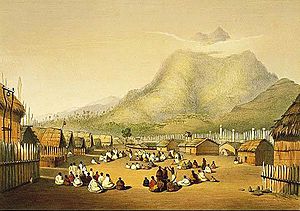Mount Taupiri facts for kids
Mount Taupiri is a special hill located at the southern end of the Taupiri Range in the Waikato region of New Zealand. It's the tallest peak in its range, reaching 288 meters (about 945 feet) above sea level. The hill looks over the small town of Taupiri, which is just to its south.
The Waikato River, New Zealand's longest river, flows through a narrow passage called the Taupiri Gorge. This gorge separates Mount Taupiri from the Hākarimata Range to the south. The Mangawara Stream also joins the Waikato River right at the base of Mount Taupiri.
Contents
Mount Taupiri: A Sacred Place
Mount Taupiri is a very important and sacred place for the Waikato tribe of the Māori people. It has been used as a burial ground for many years.
Kaitotehe Village and Early History
A long time ago, in the 1800s, there was a large Māori village called Kaitotehe. It was located on flat land across the Waikato River from Mount Taupiri, below the Hākarimata Range.
Kaitotehe was once home to Paoa, who was the brother of Mahuta. Later, it became the main base for the Ngāti Mahuta people. Two brothers, Whare and Tapuae, who were leaders of Ngāti Mahuta, lived there.
Te Putu's Pā and Its Sacredness
After Whare and Tapuae were killed, Tapuae's son, Te Putu, built a fortified village called a pā on top of a part of Taupiri mountain. This happened in the 1600s.
When Te Putu was an old man in the 1700s, he was sadly killed by a person from the Ngāti Raukawa tribe. He was buried at the pā. Because of this, the pā became tapu, which means it was made sacred and was no longer used as a living area. Early European travelers were asked by Māori people to cross to the other side of the Waikato River to avoid this sacred area.
Mount Taupiri and the Māori King Movement
In the early 1800s, Kaitotehe village was the home of Pōtatau Te Wherowhero. He was the main chief of Ngāti Mahuta and later became the first Māori King.
A Glimpse into the Past: Angas's Painting
In 1844, an English explorer and artist named George French Angas visited Kaitotehe. He painted a scene showing a hui (a Māori meeting) happening in the village. In his painting, Mount Taupiri can be seen in the background, across the Waikato River.
The painting also shows signs of the old terraces from Te Putu's abandoned pā on the lower part of the mountain. To the left of this, there's a smaller, bush-covered hill. This was the burial ground during Te Putu's time, and his home, Te Mata-o-tutonga, was located below it.
The Burial Ground Today
The current burial ground on Mount Taupiri is on a steep slope, right above State Highway 1 and the North Island Main Trunk railway line. It used to be difficult to park and get to the site because the road and railway were built on land that was taken from the river.
However, access has been made better with a new bridge from the Taupiri township over the Mangawara Stream, which opened in May 2020. The Māori kings and queen who have passed away are buried in the highest part of the cemetery. This is the same spot where Te Putu's pā once stood.


